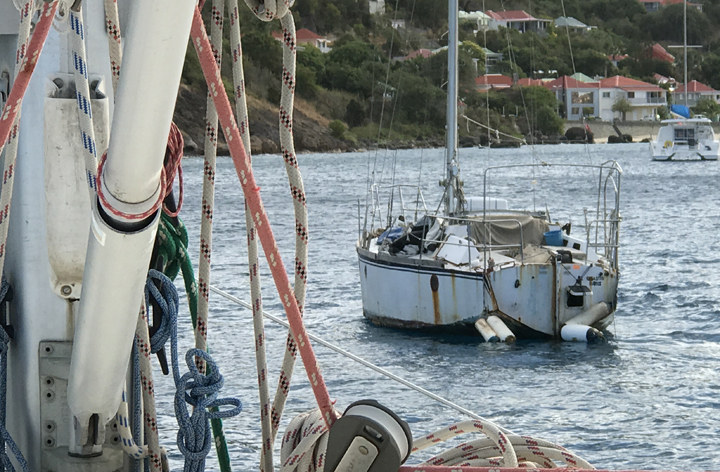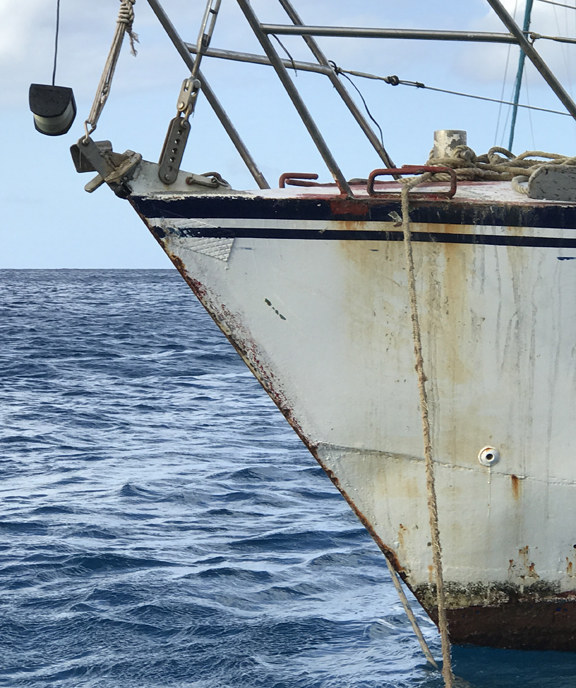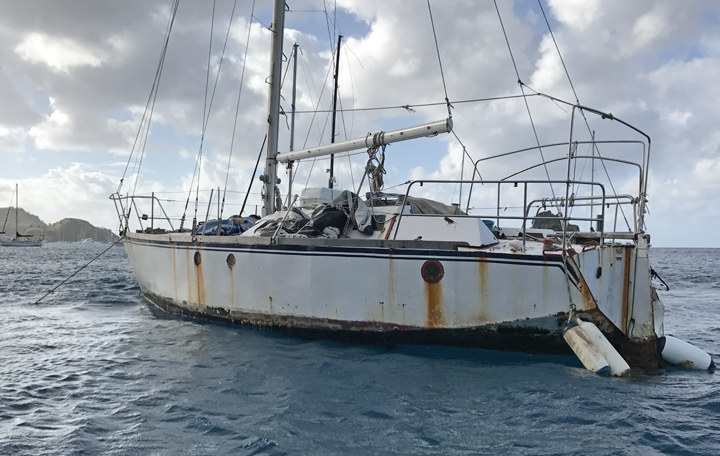
Expect the Unexpected

©2017Latitude 38 Media, LLC
Determined to live life to the fullest, last night the Wanderer and Doña de Mallorca battled the intermittent rain and 20- to 30-knot winds in St. Barth to make the one-mile-plus dinghy ride to shore for dinner and socializing in Gustavia. We felt confident that our catamaran ’ti Profligate would be all right, as we had her in perfect position in the lee of the big hill just to the north of Corossol, and she had plenty of space with regard to the many boats in her general vicinity.
As it turned out, the ride ashore wasn’t that bad. In fact, the only really bad part was the dinghy dock, which was one rocking mess. The Côtes du Rhône and filet at L’Entr’acte were delicious, however, and more than made up for it. The beef is raised in Canada, shipped to Los Angeles, shipped again to Miami, transferred to St. Martin, and then the restaurant owner has to go to the dock in St. Barth with special papers to pick it up. By necessity it’s what you’d call well-aged meat.
Once we got outside Gustavia Harbor, the ride back out to ‘ti Profligate wasn’t too bad either. Sure, there was four inches of water in the bottom of the dinghy and the Wanderer took some spray, but the water in the tropics is warm. Then we had another unexpected surprise.
Despite the well-known predictions of strong winds, some genius had anchored his boat just one boatlength directly in front of our cat. And she wasn’t just any boat, but rather a very rusty, hard-chine steel boat with, as we soon found out, no sails and no operating engine.
The mystery was how the boat got there in the first place. We’d seen her the previous two days anchored about 200 yards to the north, away from all other boats and in perfect position for the blow. How and why had she been moved to a position directly upwind of us was baffling.
We hollered to the guy in the steel boat. He told us he was sorry, but not to worry as he had two anchors set. Besides, he said, he couldn’t move because he didn’t have a working engine or sails. Or a windlass.
In other words, his two anchors were splayed out, insuring that if we raised our single anchor to move to safety, our anchor would snag one of his anchors and we’d have a real cluster, stuck together and drifting down onto the other boats in the middle of the night.
I went over to inspect his boat and wished I hadn’t. I don’t know how much chain he had out, but the rope that was showing on both rodes was thin and already worn. And as there was no bow roller for either, the rope rubbed against raw steel.
It was also clear to me that he’d taken in some of the rode on both anchors to stay even a boatlength upwind of my cat. We were in about 35 feet of water, which suggested that he might be short of the necessary amount of rode. Great.

©2017Latitude 38 Media, LLC
All in all, it was a terrible way to end what had been a great night. The Wanderer wanted to put fenders on the port side of ‘ti Profligate, then slowly move forward to raise our anchor and set it elsewhere. It might mean I’d have to slice one of his anchor rodes, but that would be his tough luck.
No fan of bold actions, de Mallorca had a fit at this suggestion and didn’t want any part of it. While the other guy surely didn’t have insurance, I did. Having insurance is hardly the magic elixir, however, if your boat, pulpits and lifelines get smashed up, and you have a $5,000-$10,000 deductible.
In the end, the big hill won out. It seemed to be blocking most of the wind, so the Wanderer agreed to hit the bunk with fingers crossed. The plan was to move the cat first thing in the morning.
The other boat made it through the night without dragging. But the skipper of the other boat was gone to shore at dawn, making moving my cat problematic.
Doña has decided to stay on the boat. “What should I do if the boat drags down on us?” she asked.
“Stay the hell out of the way and don’t get hurt,” I told her.

©Latitude 38 Media, LLC
Officials from the port captain’s office came by later on, and de Mallorca explained the situation. They said they knew the guy and the boat, and sympathized with our situation. They said they would put a warning sticker on his boat. We’re not sure that’s going to keep his boat from hitting ours, but that’s as much as they were willing to do.
It’s supposed to blow hard for two more days. We’ll have to see how it goes.
Normally we’d ask if you’ve ever found yourself in a similar situation, but we’re sure you never have.
